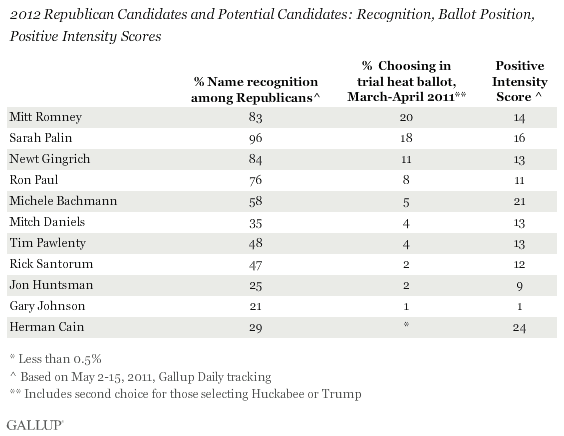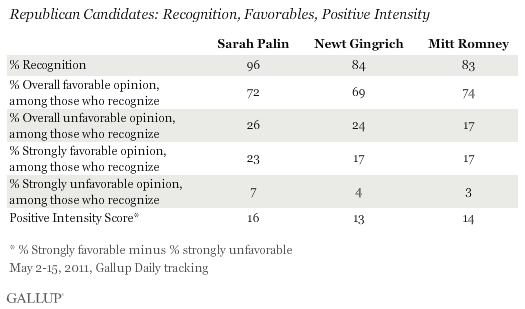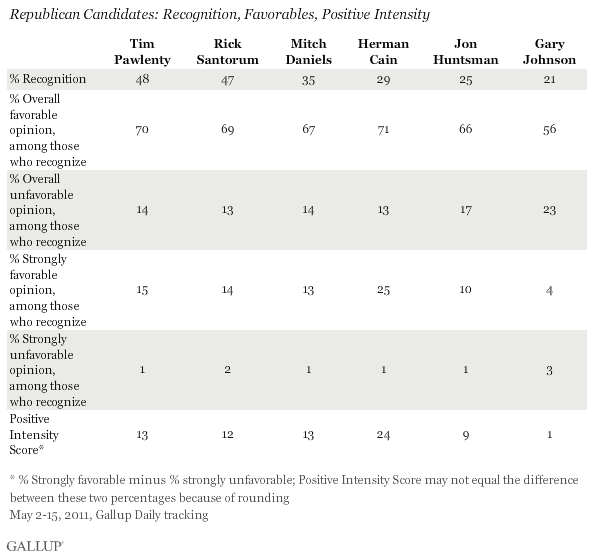PRINCETON, NJ -- With Mike Huckabee out of the race for the 2012 GOP presidential nomination, three well-known politicians, Mitt Romney, Sarah Palin, and Newt Gingrich, emerge as leaders in Republicans' preferences. Republicans, however, have less intensely positive feelings about these three than they did about Huckabee. Two less well-known potential candidates, Michele Bachmann and Herman Cain, generate high levels of enthusiasm among Republicans who recognize them.

The accompanying table displays potential Republican candidates' nomination support from March and April, based on reallocating choices of those who initially supported Huckabee or Donald Trump, and Positive Intensity Scores and name recognition for the two weeks ending May 15.
Republicans' nomination preferences at this point largely appear to reflect name identification. Palin, Gingrich, and Romney are the three best-known candidates, and they top the list of Republicans' preferences. Romney and Palin are essentially tied; Gingrich does slightly less well even though he and Romney have nearly identical name identification.
Ron Paul and Bachmann are the only other potential candidates with name recognition above 50%. They are also next in line in terms of Republican nomination support.
The remaining six candidates ÆéûÜǨû§tracks -- Tim Pawlenty, Rick Santorum, Mitch Daniels, Cain, Jon Huntsman, and Gary Johnson -- have name recognition scores of less than 50% among Republicans. Each of them has less than 5% support in the March-April reallocated trial heat.
All in all, the basic pattern is clear: The most well-known candidates lead in nomination support at this point, while those who are not as well-known lag behind.
Positive Intensity Scores Control for Recognition
A review of the GOP candidates' favorable ratings and Positive Intensity Scores reveals their strengths once name identification is controlled for.
Republican candidates can be divided into three groups based on their recognition scores.
Group 1: Palin, Gingrich, and Romney

- Palin, Gingrich, and Romney have roughly similar favorable percentages among Republicans who recognize them.
- Palin and Gingrich generate slightly higher negatives than does Romney.
- Palin's support is the most intense. A higher percentage of Republicans have strongly favorable opinions than is the case for the other two, giving her a slightly higher overall Positive Intensity Score despite her higher strongly unfavorable percentage.
- Gingrich and Romney have similar Positive Intensity Scores.
- The overall differences in Republicans' views of these three well-known candidates are not large.
Group 2: Paul and Bachmann

- Paul receives lower favorables than the three candidates in the top tier, or compared with Bachmann. Paul's Positive Intensity Score is below average.
- Bachmann's image among those who recognize her is as positive as that of any candidate tested. Bachmann has low unfavorables, similar to Romney's.
- Bachmann generates as high a percentage strongly favorable as anyone tested in this analysis. Bachmann's overall Positive Intensity Score of 21 is the highest of any of the better-known candidates, and overall is second only to that of the less well-known Cain.
Group 3: Pawlenty, Santorum, Daniels, Cain, Huntsman, and Johnson

- Pawlenty and Santorum are the best known of this group, with recognition scores just under 50%.
- Pawlenty and Santorum have similar favorable images among Republicans who recognize them (about average for the candidates).
- Daniels, who is less well-known, has an image profile among those who recognize him that is similar to those of Pawlenty and Santorum.
- The remaining three Republicans in this list -- Cain, Huntsman, and Johnson -- have name IDs in the 20% range.
- The exceptional individual in this group is businessman Cain. He is recognized by 29% of Republicans and receives the highest Positive Intensity Score, based on those who know him, of any candidate measured. One-quarter of those familiar with Cain have a strongly favorable view, and only 1% have a strongly unfavorable view.
- Huntsman and Johnson not only have low recognition scores, but at this point generate low levels of enthusiasm among those who do know them. Huntsman's Positive Intensity Score of 9 and Johnson's 1 are the lowest of any current or potential candidate. Trump, who has now indicated that he will not run, ended with a Positive Intensity Score of -1.
Summary: Where the Race Stands
There is no clear front-runner in the race for the 2012 Republican presidential nomination. Palin, who has given no indication of whether she will run for the nomination, has very high name identification, is near the top of Republicans' nomination preferences, and has a higher Positive Intensity Score than any other well-known candidate. Palin thus must be considered one of the GOP leaders at this point. Romney and Gingrich are also well-known. Of the two, Romney is slightly better positioned at this point due to his higher ranking in Gallup's trial heats.
None of these three, however, comes close to generating the positive intensity of Huckabee. Palin's Positive Intensity Score, at 16, is slightly higher than Romney's or Gingrich's, but is nine points lower than Huckabee's final May 2-15 score of 25.
Paul and Bachmann are next in line in terms of their name identification among Republicans, and round out Republicans' top five candidates in the trial-heat list. Bachmann continues to generate relatively intense positive feelings among those who recognize her. Her current Positive Intensity Score is the second highest of any candidate ÆéûÜǨû§tracks, and higher than those of the better-known Republicans.
All other candidates and potential candidates ÆéûÜǨû§tracks have name recognition below 50%. Only one of them, Cain, creates strong enthusiasm among those who recognize him.
The biggest challenge for those in the Republican field beyond Palin, Gingrich, and Romney right now is increasing their name recognition. Observers continue to point to candidates such as Pawlenty, Daniels, and Huntsman as potential challengers for the GOP nomination, but none of them is known by more than half of Republicans at this point. Additionally, none of these less well-known candidates or possible candidates, except for Cain, is generating unusual enthusiasm among those who do know them, which suggests their need to attract attention to their candidacies in the months ahead.
The challenge for Bachmann and Cain will be to maintain their strongly positive positioning as they become more widely known.
Survey Methods
Results are based on telephone interviews conducted as part of ÆéûÜǨû§Daily tracking May 2-15, 2011, with random samples of Republicans and Republican-leaning independents, aged 18 and older, living in all 50 U.S. states and the District of Columbia. Questions asking about the 13 potential candidates measured in this research were rotated among randomly selected samples of Republicans each night; over the 14-day period, each candidate was rated by a minimum of 1,500 Republicans and Republican-leaning independents.
For the overall ratings of each potential candidate among Republicans and Republican-leaning independents, including recognition scores, one can say with 95% confidence that the maximum margin of sampling error is ôÝ3 percentage points. For the Positive Intensity Score for each candidate, the maximum margin of sampling error varies depending on the size of the group recognizing the candidate.
Interviews are conducted with respondents on landline telephones and cellular phones, with interviews conducted in Spanish for respondents who are primarily Spanish-speaking. Each sample includes a minimum quota of 400 cell phone respondents and 600 landline respondents per 1,000 national adults, with additional minimum quotas among landline respondents for gender within region. Landline telephone numbers are chosen at random among listed telephone numbers. Cell phones numbers are selected using random digit dial methods. Landline respondents are chosen at random within each household on the basis of which member had the most recent birthday.
Samples are weighted by gender, age, race, Hispanic ethnicity, education, region, adults in the household, and phone status (cell phone-only/landline only/both, cell phone mostly, and having an unlisted landline number). Demographic weighting targets are based on the March 2010 Current Population Survey figures for the aged 18 and older non-institutionalized population living in U.S. telephone households. All reported margins of sampling error include the computed design effects for weighting and sample design.
In addition to sampling error, question wording and practical difficulties in conducting surveys can introduce error or bias into the findings of public opinion polls.
For more details on Gallup's polling methodology, visit .
